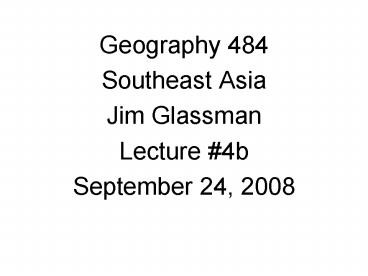Geography 484 - PowerPoint PPT Presentation
1 / 25
Title:
Geography 484
Description:
anomalies: Brunei, East Timor. Pro-capitalist versus pro-communist states ... states: Indonesia, Malaysia, Thailand, Singapore, the Philippines, Brunei ... – PowerPoint PPT presentation
Number of Views:32
Avg rating:3.0/5.0
Title: Geography 484
1
- Geography 484
- Southeast Asia
- Jim Glassman
- Lecture 4b
- September 24, 2008
2
The East and Southeast Asian miracles
- Rapid economic growth
- Industrial transformation
- Human development
3
(No Transcript)
4
(No Transcript)
5
(No Transcript)
6
(No Transcript)
7
Southeast Asian growth
- Contrast with Latin America, sub-Saharan Africa
- Contrasts within Southeast Asia
- tigers Indonesia, Malaysia, Singapore,
Thailand - laggards The Philippines, Vietnam, Laos
- basket cases Burma, Cambodia
- anomalies Brunei, East Timor
8
Pro-capitalist versus pro-communist states
- Pro-capitalist states Indonesia, Malaysia,
Thailand, Singapore, the Philippines, Brunei - Pro-communist states Burma (socialist),
Cambodia, Laos, Vietnam - Transition in the former pro-communist states
9
Issues in Southeast Asian growth
- Does capitalism provide the key to rapid growth?
- Cold War politics and growth (aid war)
- Capitalism as cause or symptom?
- Anomalies the Philippines, Vietnam
- Is neo-liberal capitalism the key to rapid
growth? - Neoliberalism (Thailand)
- Neomercantilism (Singapore and Malaysia)
10
Problematizing post-war economic growth
- The role of the Cold War in boosting the NICs
- The role of the Cold War in undermining the
pro-communist states - The role of Japan and the NE Asian NICs
- Uncertainties of the post-Cold War neoliberal era
- Internal unevenness and economic growth
11
Growth in the post-Cold War era
- 1990s boom
- Chinas rapid growth
- Increased global competition (e.g., Mexico)
- Increased Western investment and antagonism to
neo-mercantilism - Economic crisis
- Neo-liberalism cause of the crisis or solution?
12
Uneven Development
- Geographic unevenness
- Urban primacy
- Poverty in rural/agrarian regions
- Marginalization of upland ethnic groups
- Social unevenness
- Benefits of growth disproportionately for those
already most well off - Increased socio-economic disparity
13
(No Transcript)
14
Absolute versus relative poverty
- Relative poverty maldistribution of
income/wealth - Absolute poverty ability to meet basic needs
- Is it possible to have growth in relative poverty
and decline in absolute poverty?
15
Problems in measuring absolute poverty
- Definitions and meanings of poverty
- Different definitions of poverty
- Differing meanings across regions
- Incommensurability of data across countries and
regions
16
(No Transcript)
17
(No Transcript)
18
Measuring poverty
- Minimum requirements minimum food basket (based
on nutritional and market surveys) minimum
non-food needs (based on ???) - In Thailand, non-food minimum is based on average
actually spent on non-food items by bottom
quintile of income distribution. (Is this
adequate?)
19
Differing poverty lines
- Indonesian versus Malaysian poverty lines
- In 1980-81, 76.1 of Indonesians would have been
below the Malaysian poverty line, compared to the
Indonesian figure of 27.7 - Indonesian versus Thai poverty lines
- In 1985-87, 48.5 of urban and 60.1 of rural
Indonesians would have been below the Thai
poverty line, compared to the Indonesian figures
of 21.6 and 18.1 - Thai versus Malaysian poverty lines
- In 1981, 30.9 of Thais would have been below the
Malaysian poverty line, compared to the Thai
figure of 23.0
20
The need to adjust poverty lines over time
- Thai food minimum based on 1975 World Bank
survey, does not account for growth of Thai
population and increased calorie requirements (or
changing food tastes) - Official Thai poverty rate, 1992 13
- Revised 1992 estimate, based on new food basket
and other adjustments 33
21
(No Transcript)
22
Absolute poverty as relative
- Food basket minimum as socially and historically
relative - Non-food poverty as socially and historically
relative - What is the appropriate reference group in the
era of globalization? - An alternative poverty line
- 1/2 the median income
- Median income of which reference group?
23
(No Transcript)
24
(No Transcript)
25
Southeast Asian NICs
- Reductions in absolute poverty, as measured by
World Bank and others - Growth in income disparities
- Issues
- How do we understand what constitutes absolute
poverty in this context? - Social struggles over poverty and the issue of
inequality































